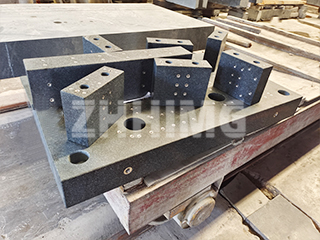Granite has become a preferred material in precision engineering applications due to its exceptional stability, vibration damping properties, and thermal resistance. The proper installation of granite machine components requires careful attention to technical details to ensure optimal performance and longevity. This guide outlines critical considerations for professionals handling these precision elements.
Pre-Installation Preparation:
Thorough surface preparation forms the foundation for successful installation. Begin with comprehensive cleaning using specialized stone cleaners to remove all contaminants from the granite surface. For optimal adhesion, the surface should achieve a minimum cleanliness standard of ISO 8501-1 Sa2.5. Edge preparation requires particular attention – all mounting surfaces should be ground to a surface flatness of at least 0.02mm/m and finished with appropriate edge radiusing to prevent stress concentration.
Material Selection Criteria:
Choosing compatible components involves evaluating several technical parameters:
• Coefficient of thermal expansion matching (granite averages 5-6 μm/m·°C)
• Load-bearing capacity relative to component weight
• Environmental resistance requirements
• Dynamic load considerations for moving parts
Precision Alignment Techniques:
Modern installation employs laser alignment systems capable of achieving 0.001mm/m accuracy for critical applications. The alignment process should account for:
- Thermal equilibrium conditions (20°C ±1°C ideal)
- Vibration isolation requirements
- Long-term creep potential
- Service accessibility needs
Advanced Bonding Solutions:
Epoxy-based adhesives specifically formulated for stone-to-metal bonding typically provide superior performance, offering:
√ Shear strength exceeding 15MPa
√ Temperature resistance up to 120°C
√ Minimal shrinkage during curing
√ Chemical resistance to industrial fluids
Post-Installation Verification:
A comprehensive quality check should include:
• Laser interferometry flatness verification
• Acoustic emission testing for bond integrity
• Thermal cycle testing (3 cycles minimum)
• Load testing at 150% of operational requirements
Our engineering team provides:
✓ Site-specific installation protocols
✓ Custom component fabrication
✓ Vibration analysis services
✓ Long-term performance monitoring
For critical applications in industries such as semiconductor manufacturing, precision optics, or coordinate measuring systems, we recommend:
- Climate-controlled installation environments
- Real-time monitoring during adhesive curing
- Periodic precision re-certification
- Preventive maintenance programs
This technical approach ensures your granite machine components deliver their full potential in terms of accuracy, stability, and service life. Contact our installation specialists for project-specific recommendations tailored to your operational requirements and environmental conditions.
Post time: Jul-25-2025

